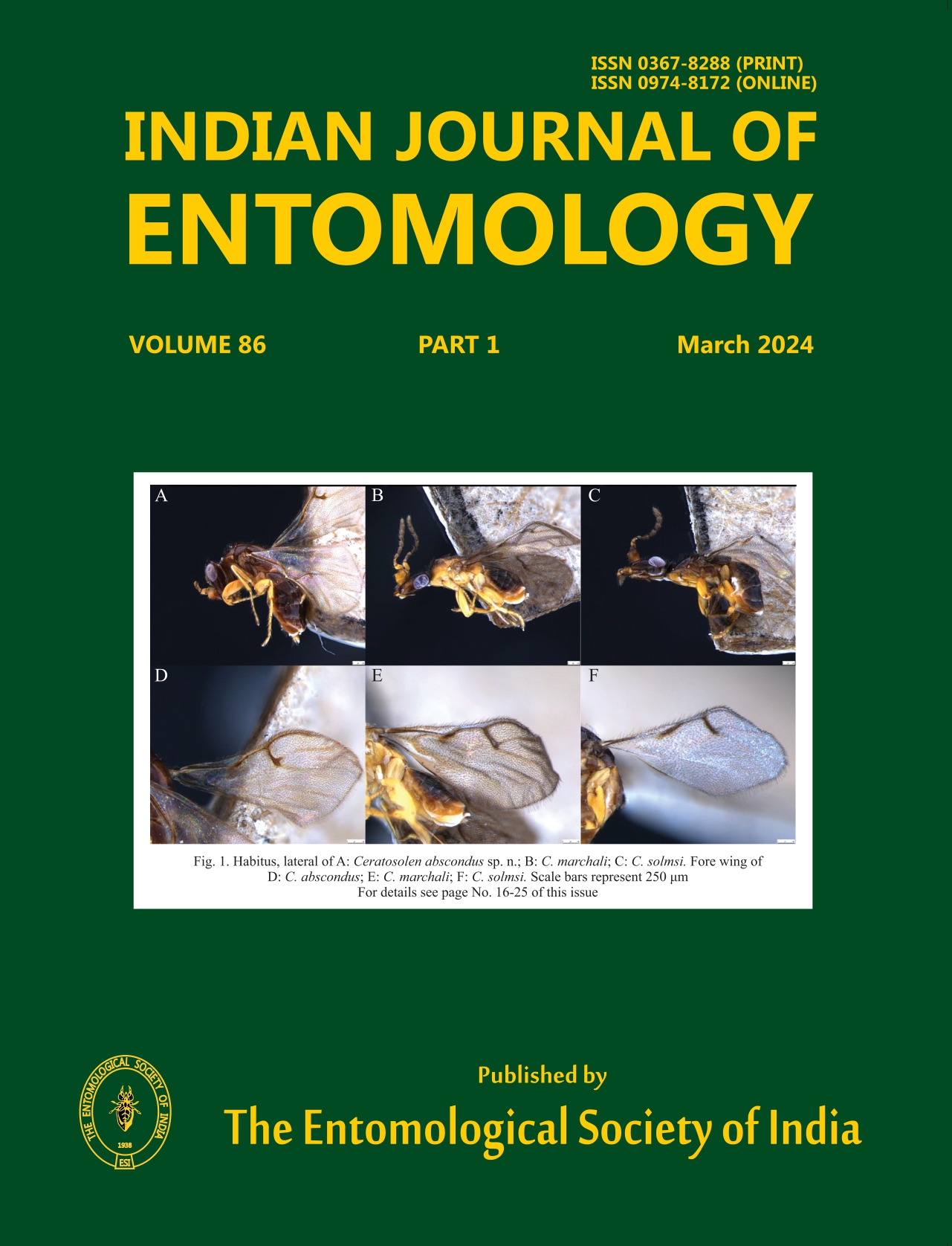A Checklist of Termite Fauna (Isoptera) of Kurukshetra, Haryana
DOI:
https://doi.org/10.55446/IJE.2023.745Keywords:
Termite, Termitidae, Rhinotermitidae, Macrotermitinae, Coptotermes Odontotermes, Kurukshetra Campus, species, genera, subfamilies, checklistAbstract
This study is aimed to know the termite community of the Kurukshetra through sampling by the random hand-picking method, and identified with the keys given by Roonwal and Chhotani, (1989) and Chhotani (1997). A total of 11 species belonging to two families (Termitidae and Rhinotermitidae), two subfamilies (Macrotermitinae and Coptotermitinae) and three genera (Odontotermes, Microtermes and Coptotermes) were observed. Out of these two species are new records from Kurukshetra i.e. Coptotermes kishori and Odontotermes profeae. Termitidae is the most diverse of the two families, and the study reveals the presence of total of 19 species under five genera, four subfamilies and two families.
Downloads
Metrics
Downloads
Published
How to Cite
Issue
Section
References
Ahmed J B, Pradhan B. 2018. Termite mounds as bio-indicators of groundwater: prospects and constraints. Pertanika Journal of Science and Technology 26(2): 479-498.
Aiman Hanis J, Abu Hassan A T N A, Nurita A T, Che Salmah M R. 2014. Community structure of termites in a hill dipterocarp forest of Belum–Temengor Forest Complex, Malaysia: emergence of pest species. Raffles Bulletin of Zoology 62: 3-11.
Basu P, Blachart E, Lepage M. 1996. Termites (Isoptera) community in the Western Ghats, South India: influence of anthropogenic disturbance of natural vegetation. European Journal of Soil Biology 32(3):113-121.
Bhanupriya, Kakkar N, Gupta S K. 2022. Eremotermes neoparadoxalis Ahmad, 1955 (Isoptera: Termitidae: Amitermitinae) a new record from Haryana, India. Journal of Threatened Taxa 14(8): 21715-21719
Chhotani O B. 1997. Fauna of India, Isoptera (Termites) Vol. 2. Zoological Survey of India, Calcutta. 800 pp.
Effowe T Q, Kasseney B D, Ndiaye A B, Sanbena B B, Amevoin K, Glitho I A. 2021. Termites’ diversity in a protected park of the northern Sudanian savanna of Togo (West Africa). Nature Conservation 43: 79-91.
Gathorne-Hardy F J. 2001. A review of the South East Asian Nasutitermitinae (Isoptera: Termitidae) with descriptions of one new genus and a new species and including key to the genera. Journal of Natural History 35: 1486-1506.
Gupta S K, Nidhi K. 2015. Community composition of termites (Isoptera) in different habitats and seasons in Kurukshetra, Haryana, India. Animal Diversity, Natural History and Conservation 5: 57-64.
Gupta S K, Bhanupriya, Kakkar N, Kundu S, Chandra K. 2021. Need for integration of morphotaxonomy and molecular signature in determination of Indian termite taxa (Insecta: Blattaria). Journal of Environment and Sociobiology 18(2): 109-124.
Kakkar N, Gupta S K, Dhanerwal S. 2015. Survey of termites (Isoptera) fauna in Kurukshetra Haryana, India. Insight an International Journal of Science 2: 26-28.
Kakkar N, Gupta S K, Saini R. 2017.Isolation of cellulolytic and amylolytic bacteria of worker and soldier termite gut (Isoptera). International Research Journal of Natural and Applied Sciences 4(10): 190-200.
Kambhampati S, Eggleton P. 2000. Phylogenetics and taxonomy. Termites: evolution, sociality, symbiosis, ecology. Abe T, Bignell D E, Higashi M. (eds.). Kluwer Academic Publishers. pp 1-23.
Krishna K, Grimaldi D A, Krishna V, Engel M S. 2013a. Treatise on the Isoptera of the world: Vol. 1-6. Bulletin of the American Museum of Natural History 377(1-7): 1-2433.
Mahapatro G K, Kumar S, Kumar M. 2018. A new record of termite Amitermes belli (Desneux) from Himachal Pradesh. Indian Journal of Entomology 80(2): 457-459.
Matsui T, Tokuda G, Shinzato N. 2009. Termites as functional gene resources. Recent Patents on Biotechnology 3: 10-18.
Paul B, Aslam Khan M D, Paul S, Shankarganesh K, Chakravorty S. 2018. Termites and Indian agriculture. Termites and sustainable management, sustainability in plant and crop protection. Khan M A, Ahmad W (eds). Springer International Publisher, New Delhi, India. pp. 52-86.
Poonia A. 2019. Termites (Insecta: Isoptera) of Haryana present state of knowledge- a review. Agricultural Research Communication Center 40(1): 59-64.
Rajmohana K, Basak J, Poovoli A, Sengupta R, Baraik B, Chandra K.2019. Taxonomy of termites in India: A beginner’s manual.ENVIS Centre on Biodiversity (Fauna), Zoological Survey ofIndia, Kolkata. 77 pp.
Ranjith M, Kalleshwaraswamy C M. 2021. Termites (Blatodea: Isoptera) of southern India: current knowledge on distribution and systematic checklist. Journal of Threatened Taxa 13(6): 18598-18613.
Roonwal M L, Chhotani O B. 1989. The fauna of India and the adjacent countries Isoptera, (Termites) Vol. 1. Zoological Survey of India, Calcutta. 672 pp.
Sattar A, Naeem M, ul-Haq E. 2013. Impact of environmental factors on the population dynamics, density and foraging activities of Odontotermes lokanandi and Microtermes obesi in Islamabad. Springer Plus 2(1): 1-7.
Scheffrahn R H, Su N Y. 1994. Keys to soldier and winged adult termites (Isoptera) of Florida. Florida Entomologist 77(4): 460-473.
Sen-Sarma P K, Thakur M L, Misra S C, Gupta B K. 1975. Studies on wood destroying termites in relation to natural termite resistance of timber. Project Report. Forest Research Institute.
Shanbhang R R, Sundararaj R. 2011. Season wood degradation activity of Odontotermes. spp. (Isoptera: Termitidae) in Bangalore urban district, India. Journal of Biodiversity and Environmental Sciences 2(1): 49-54.
Vidyashree A S, Kalleshwaraswamy C M, Sharanabasappa 2018. Termite (Isoptera) diversity in three distinct habitats of Western Ghats of Karnataka. Journal of Entomology and Zoology Studies 6(3): 1301-1303.
Wang C, Zhou X, Li S, Schwinghammer M, Scharf M E, Buczkowski G, Bennett G W. 2009. Survey and identification of termites (Isoptera: Rhinotermitidae) in Indiana. Annals of Entomological Society of America 102(6): 1029-1036.
















